30.04.2022
Sharp pictures! James Webb Space Telescope completes alignment in huge milestone
The Webb team can now proceed with science instrument commissioning.

NASA's James Webb Space Telescope can now capture sharp images of celestial objects with multiple instruments, the agency announced April 28, 2022. (Image credit: NASA/STScI)
NASA's view of deep space just got sharper.
The James Webb Space Telescope finished its alignment phase after demonstrating it can capture "crisp, well-focused images" with all four of its science instruments, the agency announced Wednesday (April 28).
The milestone, which NASA showcased with some new Webb images, allows the mission team to proceed with science instrument commissioning. The telescope will thus enter a new phase of preparation after several months of mirror and instrument alignments. This next step will take roughly two months, with Webb remaining on track to finish in June if everything goes to plan.
"These images have profoundly changed the way I see the universe," Scott Acton, Webb wavefront sensing and controls scientist at Ball Aerospace, said in the NASA statement. "We are surrounded by a symphony of creation; there are galaxies everywhere. It is my hope that everyone in the world can see them."
It's been a busy time for the $10 billion telescope since its launch on Dec. 25, 2021. First, Webb had to rocket to deep space, a process that took almost a month, and then it had a complex, seven-step alignment process to get through. Each milestone has gone pretty much to plan, with only minor tweaks required along the way.
A week ago, Webb officials reported that the 18 hexagonal segments of the scope's primary mirror were almost completely cooled to the deep-space temperatures they require to see objects sharply in infrared light. Now the mirrors appear to be ready, as they are sending "fully focused light" into every instrument, which in turn is rendering images.
"The optical performance of the telescope continues to be better than the engineering team's most optimistic predictions," NASA officials said in the statement, noting that the image quality is only "diffraction limited." (That means the only obstacle to seeing fine detail is the size of the telescope, rather than a problem with its performance.) From here on, the agency added, mirror alignments will need only minor adjustments.
The next phase of work will include science instrument commissioning, along with telescope calibration. Instrument commissioning requires lenses, masks, filters and other equipment to work properly in different configurations, to make sure they can perform science work.
As for calibration activities, there's a list of milestones that Webb will need to hit before it is declared operational.
"The telescope will be commanded to point to different areas in the sky, where the total amount of solar radiation hitting the observatory will vary to confirm thermal stability when changing targets," NASA officials said of the calibration.
"Furthermore, ongoing maintenance observations every two days will monitor the mirror alignment and, when needed, apply corrections to keep the mirrors in their aligned locations," they added.
Quelle: SC
----
Update: 4.05.2022
.
NASA’s Webb Telescope mirror crushes “most optimistic predictions” after final alignment

NASA says that the nascent James Webb Space Telescope’s (JWST) “optical performance…continues to be better than the…most optimistic predictions” after completing the alignment of its record-breaking mirror.
Between 7 and 14 years behind schedule and over budget by a factor of 2 to 10, an Arianespace Ariane 5 rocket sent the Webb Telescope on its way to deep space on December 25th, 2021. Weighing 6.2 tons (~13,600 lb), JWST was almost half as heavy at liftoff as NASA’s iconic Hubble Space Telescope despite packing an unprecedented origami-like mirror with more than six times Hubble’s total collecting area. The combination of extreme mass reduction and extraordinary complexity required to launch such a large mirror so far from Earth with a rocket like Ariane 5 helps to partially explain why the Webb Telescope took so long (~18 years) and cost so much (~$9.7 billion) to design, develop, and build.
Nonetheless, launch it finally did. Ariane 5 did most of the work, sending the telescope on a trajectory that – with some help from its onboard thrusters – would guide it to the Sun-Earth L2 Lagrange point located some 1.5 million kilometers (~950,000 miles) from Earth. In perhaps the largest relief in the history of space-based observatories, the Webb Telescope’s immensely complex deployment process was then completed without a single major issue. 30 days after liftoff, the telescope – fully deployed – reached its operational orbit.
For the past four months, in comparison, almost all JWST work has focused on the less visible and far smaller processes of alignment and calibration. Each of JWST’s 18 main mirror segments has slowly but surely inched micrometer by micrometer into position while large swaths of the telescope slowly cooled to ambient temperatures – essential for maximum performance. Simultaneously, all of Webb’s primary instruments have achieved first light and entered the early phases of calibration and commissioning. Only after the instruments are painstakingly calibrated, the mirror is perfectly aligned, and crucial hardware is chilled to temperatures as low as -449°F (-267°C) can Webb begin to observe the universe and revolutionize large subsets of space science.
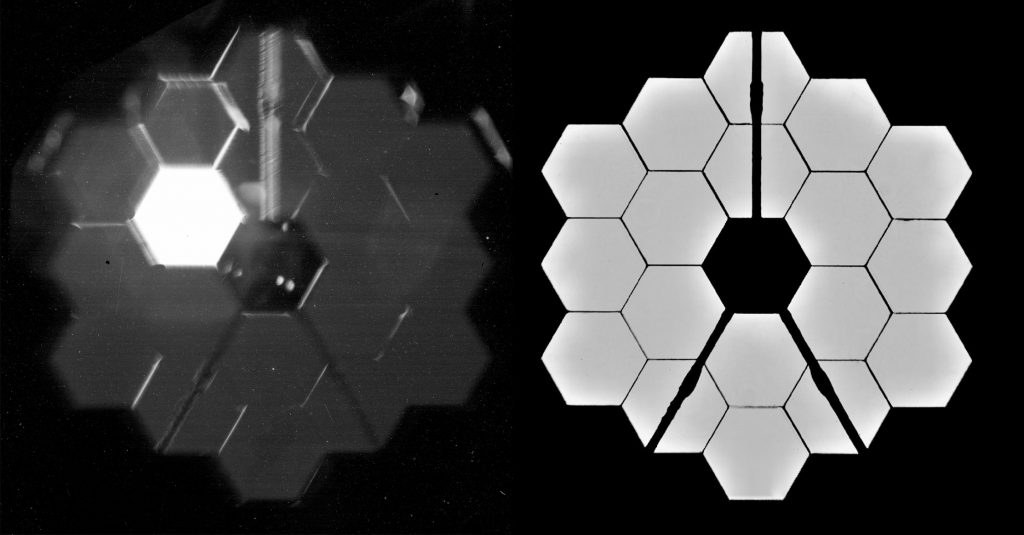
The first and most important step – mirror alignment – is now complete. The alignment process began in February 2022, six weeks after liftoff. First, images were captured with the unaligned mirror to help determine exactly what condition it was in. One by one, each of Webb’s 18 mirror segments were individually moved to determine which image each mirror was responsible for, which then allowed ground controllers to properly focus each mirror’s view of a target star. In a process known as “coarse phasing,” once those 18 points of light well-resolved and linked to a specific mirror segment, the segments were gradually steered on top of each other to produce a single image.
“Coarse” heavily undersells the almost unfathomable precision required to complete the step. To reach its full potential, each of the Webb Telescope’s mirror segments must be aligned to within 50 nanometersof each other. According to NASA, “if the Webb primary mirror were the size of the United States, each segment would be the size of Texas, and the team would need to line the height of those Texas-sized segments up with each other to an accuracy of about 1.5 inches.”
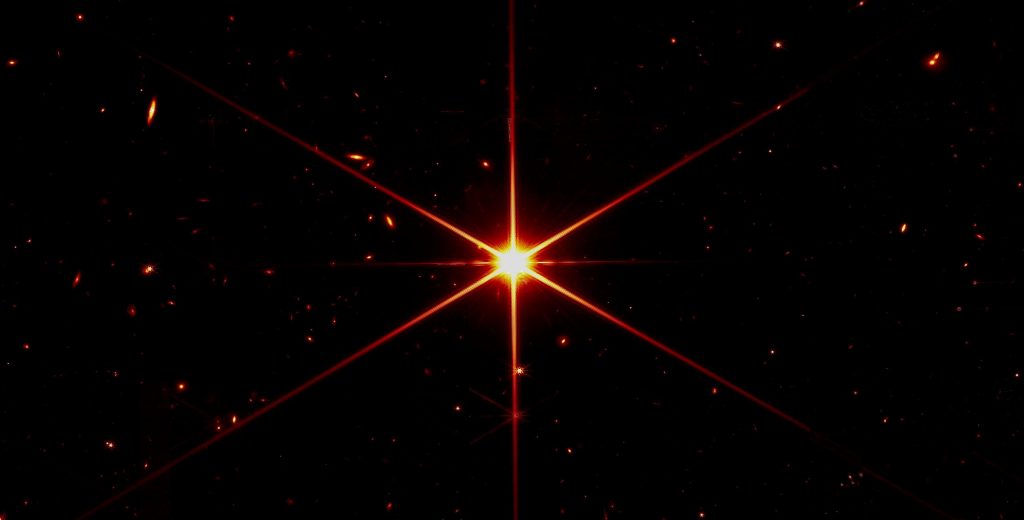
Fine phasing followed, involving an even more esoteric set of processes designed to focus the mirror as perfectly as possible. The resulting image was then tweaked to properly align it over the field of view of each of the Webb Telescope’s four main scientific instruments. Finally, some steps of the seven-step alignment process were redone or refined to fully optimize the mirror to the liking of its Earthbound creators and prospective users.
Ultimately, Webb Telescope alignment was extraordinarily successful, producing an image sharper and cleaner than even the “most optimistic predictions” made by its engineers. NASA says that the image is so detailed that it has effectively reached the physical resolution limit for a mirror the size of the Webb Telescope’s, meaning that it would have to violate the known laws of physics to resolve any more detail.
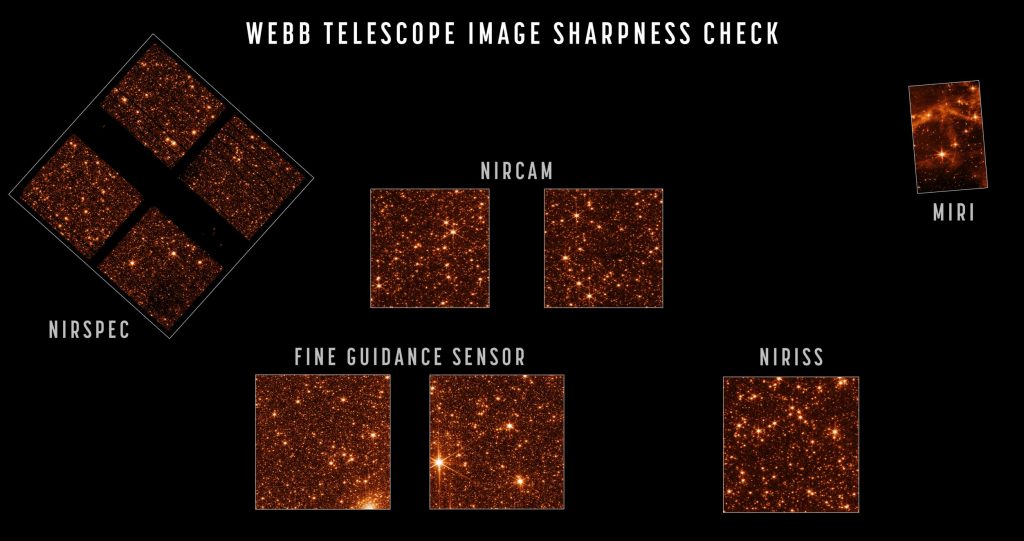
With mirror alignment complete, JWST has just one main hurdle left before science operations can begin: instrument commissioning. Commissioning is a catch-all phrase that covers a wide range of calibration, analysis, experiments, and optimization required to verify that JWST’s four main instruments are behaving as expected and accomplishing the work they were designed to do as accurately and reliably as possible.
At some point, the use of extraordinarily complex scientific instruments becomes more akin to an art form, and some degree of trust must be built up between scientists and their hopeful tools of the trade before they can confidently set chisel to marble and begin delving into the universe at unprecedented breadth and detail. If commissioning proceeds as smoothly as deployment and alignment, the JWST team could be ready to capture and share the telescope’s first actionable observations of the cosmos as early as July 2022.
Quelle: TESLARATI
----
Update: 8.05.2022
.
James Webb Space Telescope begins final check-outs before science observations
Here's what's left for the observatory to tackle.
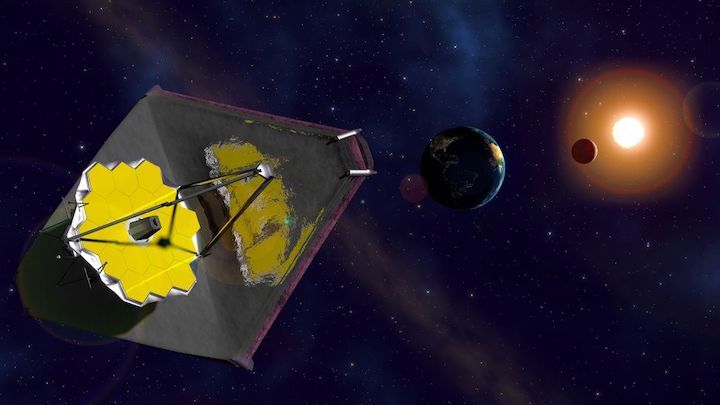
NASA's next-generation observatory is entering the last stages of preparation before showing scientists an all-new view of the universe.
Engineers are preparing to make final tweaks to the instruments on board the James Webb Space Telescope as the observatory readies for operations this summer. NASA said the telescope has "calibrations and characterizations of the instruments using a rich variety of astronomical sources" coming up shortly to make sure everything is working before Webb is set loose to examine the early universe.
"We will measure the instruments' throughput — how much of the light that enters the telescope reaches the detectors and is recorded," Scott Friedman, lead commissioning scientist for Webb at Baltimore's Space Science Telescope Institute, said in NASA statement Thursday (May 5).
While no telescope can accurately collect every photon that comes through to it, engineers will still want to know the throughput at several light wavelengths to assess Webb's performance at gathering infrared light, Friedman said.
Friedman emphasized the commissioning is "almost there," as the telescope is in the last two month of the process, which began after Webb's launch on Dec. 25, 2021. Once the instruments are assessed properly, he said, "we will be ready to begin the great science programs that astronomers and the public alike have been eagerly awaiting."
The team has been releasing a few commissioning images along the way, and a notable commissioning target is coming into focus soon: the Large Magellanic Cloud. While Friedman did not say if this galactic neighbor to the Milky Way will be included in early release images, he noted that examining the galaxy will be helpful to calibrate any distortion.
The Webb telescope will also be assessed even further for its sharpness of stellar images, through all of the instruments' optics. Each instrument is working fine with the optics tested so far, Friedman noted, but additional filters and a tool called "diffraction grating" (which spreads light into constituent colors) will also be assessed.
The team will also certify the observatory's target acquisition to make sure the telescope can point with precision down to a hundredth of an arcsecond, which will be useful for exoplanet observations.
"The star has to be placed behind a mask so its light is blocked, allowing the nearby exoplanet to shine through," Friedman said. "In time series observations, we measure how an exoplanet's atmosphere absorbs the stellar light during the hours it takes to pass in front of its star, allowing us to measure the properties and constituents of the planet’s atmosphere."
A last final testing activity will be observing moving targets such as planets, satellites, rings, asteroids and comets. "Observing these requires that the observatory change its pointing direction relative to the background guide stars during the observation," Friedman said. "We will test this capability by observing asteroids of different apparent speeds using each instrument."
NASA plans to update the public on Webb's progress on Monday (May 9) and a livestream of the discussion will be available online.
Quelle: SC
----
Update: 11.05.2022
.
JWST entering “home stretch” of commissioning
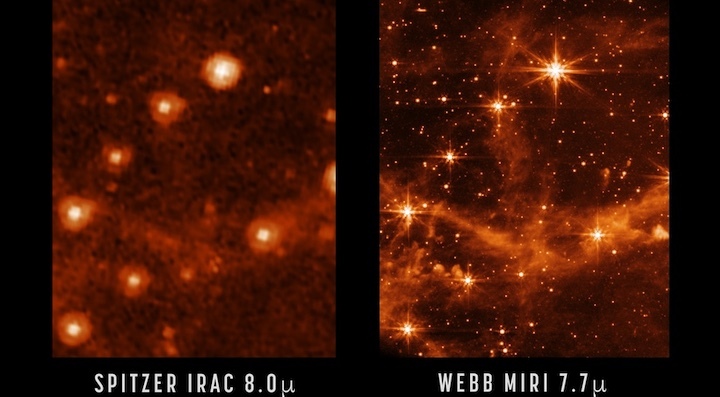
WASHINGTON — The James Webb Space Telescope is operating better than expected as the spacecraft enter the final stages of commissioning, project officials said May 9.
In a call with reporters, scientists and mission managers said they have completed the alignment of the telescope’s optics with all its instruments and now are moving into setting up the instruments for science operations, the final step in a commissioning process that started shortly after the telescope’s launch on Christmas Day last year.
“The performance is even better than we anticipated,” said Michael McElwain, JWST observatory project scientist at NASA’s Goddard Space Flight Center. “We’ve basically reached a perfect telescope alignment. There are no adjustments of the telescope optics that would make material improvements to our science performance.”
Asked later to quantify that “better than expected” performance, he said a parameter known as the static wavefront error is “significantly better” than planned for. “What that means is that we put the telescope mirrors into position with better accuracy and precision than what we had budgeted for, so we’re doing much better than requirements.” That reduced error, he said, improved both the sensitivity and resolution of the instruments.
Marcia Rieke, principal investigator of one of JWST’s instruments, the Near-Infrared Camera (NIRCam), said that images taken by the instrument show that the telescope resolution is diffraction limited at key wavelengths, meaning its images are as sharp as possible under the laws of physics. “It’s just amazing that the image quality is that excellent, and that’s going to help our science quite a bit,” she said.
With the telescope alignment completed, the project is moving the final phases of commissioning, which include preparing the instruments for science operations. “It’s the time we’re doing all the requisite checkouts and calibrations before we start science,” McElwain said.
“I would also call this the home stretch,” he added. “We’ve had about 1,000 activities planned for all of commissioning, and there are only about 200 activities left to complete.”
That process will take about two months. The mission will wrap up that commissioning with the public release of what it calls “early release observations,” an initial set of images designed to showcase the telescope’s capabilities.
“Their objective is to demonstrate, at the end of commissioning, to the world and to the public, that Webb is fully operational and that it produces excellent results,” said Klaus Pontoppidan, JWST project scientist at the Space Telescope Science Institute. Formal science operations through a program of observations called Cycle 1 will begin after the early release observations are made public, which he said is tentatively planned for mid-July.
Those early release observations will involve all four science instruments and cover a range of objects. Pontoppidan said a committee developed a ranked list of objects to include among the early release observations, but declined to say what objects are included in that list. One reason, he said, is that the objects selected could change depending on when observations can be scheduled. Also, he added, “we’d really like to be a surprise.”
Quelle: SN
----
Update: 3.06.2022
.
James Webb Space Telescope will release its 1st science-quality images July 12
It will be the day we've all been waiting for.
We now have a date for our first real images from NASA's next-generation observatory.
Following half a year of commissioning in space, NASA will release the first operational images taken by the $10 billion James Webb Space Telescope on July 12, according to an agency statement posted Wednesday (June 1). While Webb officials are still keeping those first imaging targets secret, the agency emphasized that it took five years of work among the several participating space agencies to decide what those first images will show.
"Our goals for Webb's first images and data are both to showcase the telescope's powerful instruments and to preview the science mission to come," astronomer Klaus Pontoppidan, Webb project scientist at the Space Telescope Science Institute, said in the statement(opens in new tab). "They are sure to deliver a long-awaited 'wow' for astronomers and the public."
Although the Webb team has shared several images already, these were all interim alignment images taken to evaluate the observatory's capabilities. The July 12 images will come after each instrument is "calibrated, tested, and given the green light by its science and engineering team," according to NASA.
NASA emphasized that despite all the months of careful alignment since the Dec. 25, 2021, launch of Webb, it is difficult to predict exactly how the new images will look. The high-resolution infrared view of the universe will be unique, as Webb operates in deep space and has an 18-segment hexagonal mirror that collects sharp images expected to show the first galaxies, early in the history of the universe.
The new images will be available in full color and will be meant to show the breadth of Webb's science capabilities, NASA said. This means the images will not only be included, but also spectroscopic data to show elemental composition and other information that astronomers can infer from the spectrum of light.
"The first images package of materials will highlight the science themes that inspired the mission and will be the focus of its work: the early universe, the evolution of galaxies through time, the lifecycle of stars, and other worlds," NASA said. "All of Webb's commissioning data — the data taken while aligning the telescope and preparing the instruments — will also be made publicly available.

A comparison of views of the same part of the sky as seen by NASA's retired Spitzer Space Telescope and the newly launched James Webb Space Telescope. (Image credit: NASA/JPL-Caltech (left), NASA/ESA/CSA/STScI (right))
While we wait for the big reveal, we do know what Webb will focus on in its first year of operations, called Cycle 1. The agency has already published(opens in new tab) the list of planned investigations following a competition within the science community to determine the highest-priority work, a process that will repeat each year of the observatory's lifetime.
“As we near the end of preparing the observatory for science, we are on the precipice of an incredibly exciting period of discovery about our universe," Eric Smith, Webb program scientist at NASA, said in the statement. "These images will be the culmination of decades of dedication, talent, and dreams — but they will also be just the beginning."
Quelle: SC
----
Update: 16.06.2022
.
NASA Invites Media, Public to View Webb Telescope’s First Images
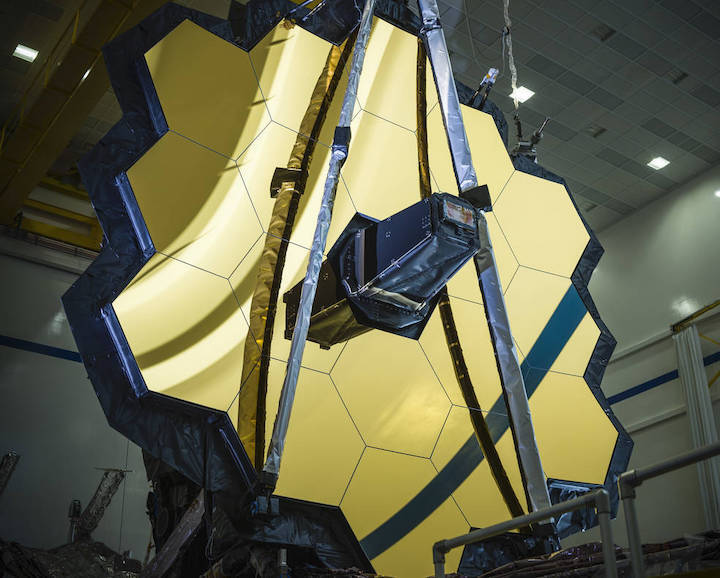
An image of the James Webb Space Telescope taken on March 5, 2020.
NASA, in partnership with ESA (European Space Agency) and CSA (Canadian Space Agency), will release the James Webb Space Telescope’s first full-color images and spectroscopic data during a televised broadcast beginning at 10:30 a.m. EDT on Tuesday, July 12, from NASA’s Goddard Space Flight Center in Greenbelt, Maryland.
Released one by one, these first images from the world’s largest and most powerful space telescope will demonstrate Webb at its full power, ready to begin its mission to unfold the infrared universe.
Each image will simultaneously be made available on social media as well as on the agency’s website at:
Embargoed access to Webb’s first images will not be available prior to their public release.
The following is a list of activities leading up to release (all times Eastern):
Wednesday, June 29
Media Day at Webb’s Mission Operations Center
NASA will host a media day at the Space Telescope Science Institute (STScI) beginning at 10 a.m. on Wednesday, June 29. The event will include a media briefing on the status of Webb’s commissioning as well as overviews of planned science for Webb’s first year of operations and Webb image processing.
On-site attendees can tour Webb’s Mission Operations Control facilities, including the Flight Control Room, and conduct interviews with mission experts.
Media must register their interest in participating by completing this form by 3 p.m. EDT Tuesday, June 21, for in-person, and by 3 p.m. EDT Tuesday, June 28, for virtual.
NASA and STScI will soon provide further details to those who register their interest, including the full media day schedule and COVID-19 safety protocols. Due to space limitations, NASA and STScI may be unable to accommodate all requests for on-site attendance.
Tuesday, July 12
Image Release Day
- 10:30 a.m. – Live coverage of the image release broadcast will air on NASA TV, the NASA app, and the agency’s website. The public also can watch live on Facebook, Twitter, YouTube, Twitch, and Daily Motion.
- 12 p.m. – Following the live broadcast, NASA and its partners will hold a joint media briefing at NASA Goddard. The briefing will livestream on NASA TV, the NASA app, and the agency’s website. The list of media briefing participants is forthcoming, and this advisory will be updated with details later.
Media interested in participating in-person must complete this form by 3 p.m. EDT Tuesday, June 21.
- 3 p.m. – Live Interview Opportunities: From approximately 3 to 7 p.m. on Tuesday, July 12, and 6 a.m. to 1 p.m. on Wednesday, July 13, Webb mission experts will be available to conduct live, remote interviews with broadcast media. Experts will be available to conduct interviews in both English and Spanish. More details about scheduling these interviews will be made available closer to the date. Members of the media seeking interviews outside of these windows should complete this media interview request form.
NASA’s media accreditation policy for on-site and virtual activities is available online. The agency will soon provide further details to those who register their interest, including COVID-19 safety protocols. Due to space limitations, NASA may be unable to accommodate all requests for on-site attendance. Media and members of the public may ask questions on social media using #UnfoldtheUniverse.
Wednesday, July 13
3 p.m.: NASA Science Live
Webb experts will answer questions about the first images and data in a NASA Science Live show. The broadcast, Webb’s First Full-Color Images Explained, will air live on the NASA Science Live website, as well as YouTube, Facebook, and Twitter. Viewers of this episode can submit questions on social media using the hashtag #UnfoldtheUniverse or by leaving a comment in the chat section of the Facebook or YouTube stream.
At the same time, NASA also will broadcast a live social media event in Spanish on its NASA en español YouTube, Facebook, and Twitter accounts. Webb experts Begoña Vila and Néstor Espinoza will discuss the release of the first images and take questions from followers.
NASA Social
The agency also will host an in-person NASA Social Tuesday, July 12, and Wednesday, July 13. Participants will join as guests for the in-studio filming of the televised broadcast at NASA Goddard, tour NASA Goddard and STScI facilities, and interact with experts from the Webb mission.
Webb Community Events
The public can also join in the excitement of Webb’s first full-color images by attending one of the many official Webb Space Telescope Community Events taking place across the country this summer. The list of events celebrating Webb’s first images is available online and updated frequently.
Webb, an international partnership with ESA and CSA, launched Dec. 25 from Europe’s Spaceport in Kourou, French Guiana. After unfolding into its final form in space and successfully reaching its destination 1 million miles from Earth, the observatory now is completing the months-long process of preparing for science operations. Webb will explore every phase of cosmic history – from within the solar system to the most distant observable galaxies in the early universe, and everything in between.
Quelle: NASA
----
Update: 27.06.2022
.
NASA James Webb Space Telescope Crosses Halfway Point in Final Testing
It's almost time.
NASA is revving up to release its very first interstellar discoveries, courtesy of the groundbreaking James Webb Space Telescope. Come July 12, we may begin seeing the universe through a vastly clearer lens.
And in preparation for the highly anticipated day, JWST researchers have been meticulously perfecting each of the scope's trailblazing pieces of equipment -- on that note, we have an update.
NASA scientists announced this week that they've successfully calibrated the eye of a JWST-mounted device called NIRSpec. This is a pretty big milestone because of the streamlined way NASA organized the road to regular Webb use. The agency basically has to get through 17 instrument "modes," which you can think of as testing checkpoints, through analysis and observation before fully booting up JWST.
Thus, now counting NIRSpec achievements, the agency has officially passed the halfway point on the mode ledger -- bringing the grand total to 10 out of 17 complete.
"The recent confirmation of NIRSpec target acquisition ... primes the NIRSpec team for our last activities of commissioning," the team said. "We cannot wait to see the first NIRSpec science observations coming this summer!"
In fact, "the team has started to take some of the first science data," per the agency's release.
A quick recap of the James Webb specs
There are four key components to JWST, each of which contributes to those 17 modes outlined by the agency. Of note, almost all these facets rely on some type of infrared light detection, which means they can study a part of the electromagnetic spectrum invisible to human eyes.
"Study of the intensity or brightness of light across the wavelengths can provide key diagnostic information about the nature of various objects across the universe," the JWST team said. "From extrasolar planets around distant stars, to faint galaxies at the edge of the universe, and objects in our own solar system."
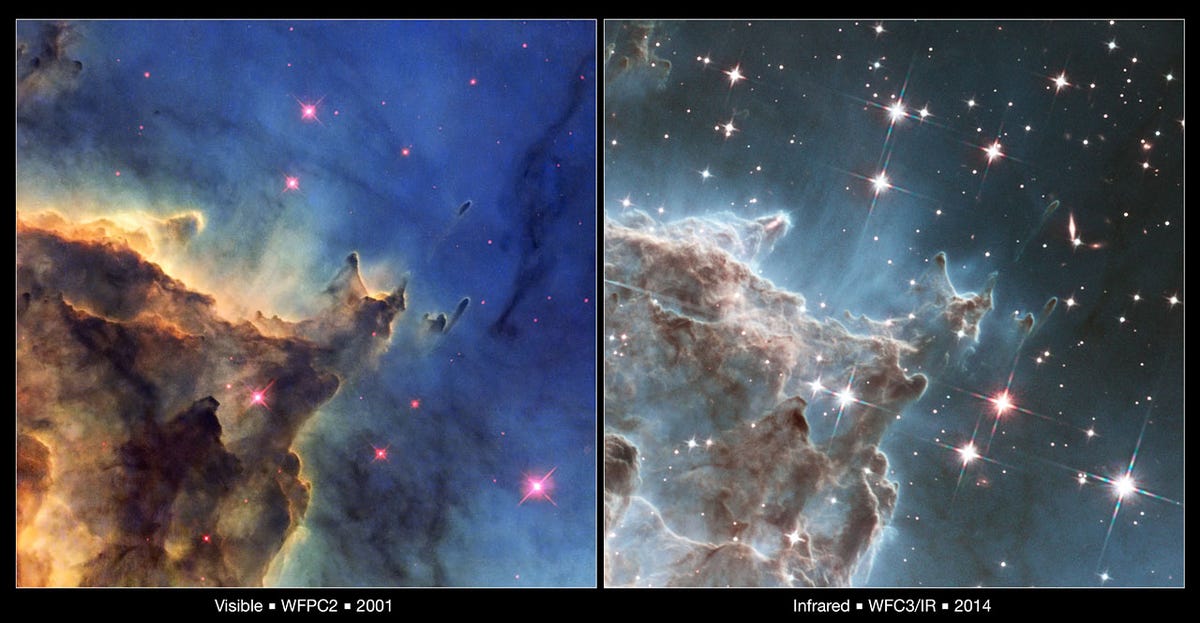
A comparison of Hubble's visible and infrared views of the Monkey Head Nebula. Though Hubble has some infrared capabilities, it's nothing compared with Webb.
NASA and ESAYou can read about the science of infrared in more detail here -- but returning to JWST's technology army, here's the breakdown.
Its alpha instrument is probably the Near-Infrared Camera, or NIRCam. NIRCam will essentially lead the charge in detecting and imaging the cosmos as it was when time began. "If NIRCam doesn't work, the telescope doesn't work," Alison Nordt, space science and instrumentation director at aerospace giant Lockheed Martin, who's been a part of the JWST since the beginning, simply puts it.
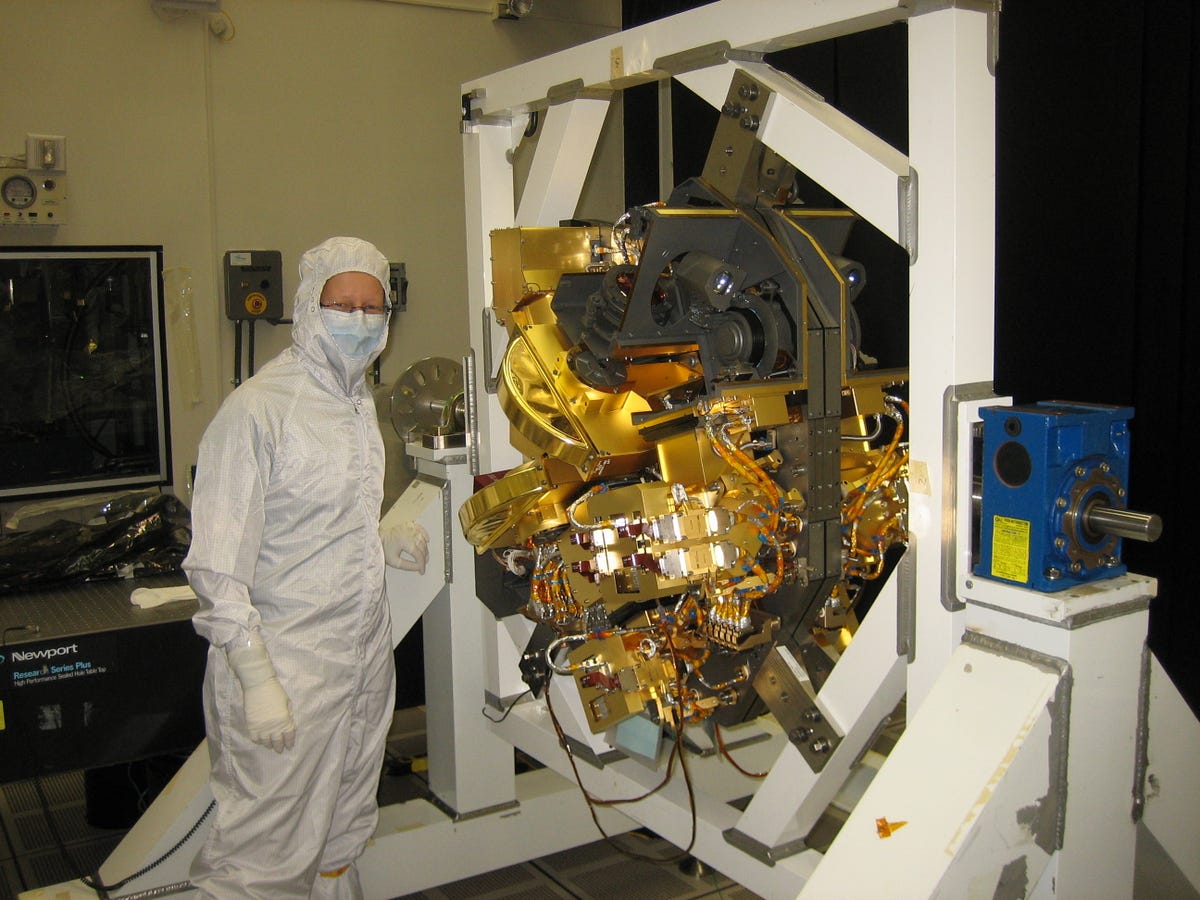
Lockheed Martin engineer Alison Nordt working on Webb's NIRCam.
Lockheed MartinThen, there's the Mid-Infrared Instrument, or MIRI, which has both a camera and spectrograph aimed at dissecting items illuminated by light in the mid-infrared electromagnetic region, and the Near-Infrared Imager and Slitless Spectrograph, or NIRISS, which is basically an exoplanet hunting machine.
Also aboard JWST, you'll find a navigation system, aka the fine guidance sensor, which helps the scope, well, not get lost. And finally, the star of NASA's latest update is the Near-Infrared Spectrograph, or NIRSpec.
What is NIRSpec?
"The Near-Infrared Spectrograph is the instrument on the Webb telescope that observes spectra of astrophysical and planetary objects at near infrared wavelengths," the JWST team said.
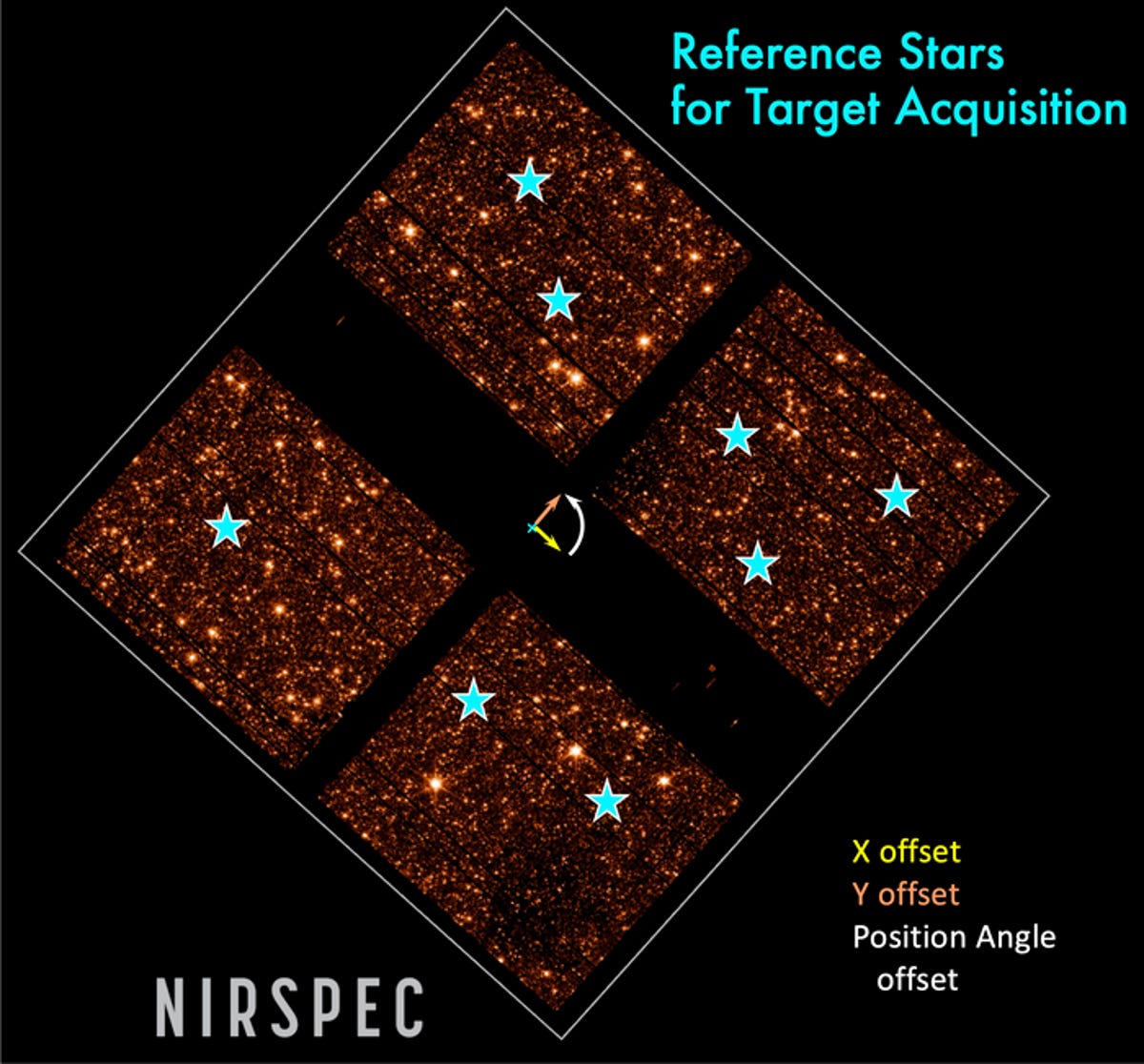
A simulation of the NIRSpec MSA-based target acquisition process, demonstrated on the NIRSpec sharpness check image. NIRSpec uses "reference Stars" that you can see here, observed through fixed slits in the device.
NASA, ESA and the NIRSpec TeamIn other words, it works to examine space-borne phenomena that emanate light in the near infrared region, but rather than merely image those objects, it can study their chemical composition. That's the intrigue of spectrography. You get more than a picture of a planet, you get details of what it would be like to stand on it.
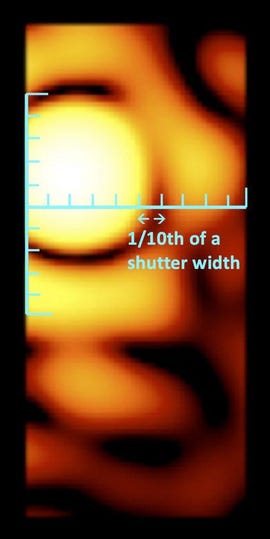
An optimized high-resolution simulation of a star seen through a NIRSpec micro-shutter. For proper intensity estimation of NIRSpec science spectra, we need to accurately know the positioning of the targets to within one tenth of the shutter width.
NASA, ESA and the NIRSpec TeamAnd in terms of target acquisition, the JWST team says NIRSpec has an important mirror, which can place cosmic targets in their proper locations as the telescope explores. This is crucial because such information helps NIRSpec's spectrograph know where to look.
There are two ways the mirror does this -- the Wide Aperture Target Acquisition (WATA) and Micro-Shutter Assembly-based Target Acquisition (MSATA). During testing, the team said, WATA performed "excellently" and MSATA made solid progress, and lucky for us, both successes give us awesome cosmic pictures, like the one featured up top.
Further, with regard to MSATA, the JWST team says this method is quite difficult to nail down. It calls for a proper estimation of iNIRSpec science spectral intensity withinone-tenth of the device's shutter width. That's incredibly precise. For context, it's "the approximate size of a bumblebee, 1.5 centimeters, viewed from 150 kilometers away," the team said.
Now that NASA has these successes down, just seven more modes to go before we hit July 12 -- the day we've all been waiting for.
To the stars, JWST.
Quelle: CNET
----
Update: 3.07.2022
.
James Webb Space Telescope's supercold camera is now ready for science
The camera images the universe in mid-infrared wavelengths and analyzes chemical compositions.
Teams preparing the James Webb Space Telescope for the commencement of its science operations have concluded the fine-tuning of the second of its four cutting-edge instruments ahead of the reveal of the telescope's first science-grade images less than two weeks from now.
The Mid-Infrared instrument (MIRI) combines a camera that images the universein mid-infrared wavelengths and a spectrograph that can capture light spectra of the observed stars and galaxies. These spectra, essentially the fingerprints of how celestial objects absorb light, reveal their chemical composition.
MIRI operates in four modes, which allow the instrument to focus on different aspects of the studied objects. The engineering team concluded the testing of MIRI by checking its coronagraphic imaging mode, which enables astronomers to mask the bulk of a star and see just the surrounding glow of the stellar atmosphere, the corona. In the corona, the James Webb Space Telescope will be able to see exoplanets orbiting those distant stars.
"We are thrilled that MIRI is now a functioning, state-of-the-art instrument with performances across all its capabilities better than expected," Gillian Wright, MIRI European principal investigator at the U.K. Astronomy Technology Center, which co-developed the instrument, said in a statement(opens in new tab).
MIRI, developed jointly by NASA, the European Space Agency (ESA) and a range of science institutions in Europe and America, requires the coldest temperature of all the Webb instruments to function properly.
Hidden behind its giant sunshield, the whole telescope had to cool down to minus 370 degrees Fahrenheit (minus 223 degrees Celsius) after its arrival at the Lagrange Point 2, a gravitationally stable point some 930,000 miles (1.5 million kilometers) away from Earth. Because Webb observes infrared light, which is essentially heat, any warmth from the telescope itself would dazzle its super-sensitive sensors.
MIRI, however, needed to get even colder — minus 447 degrees F (minus 266 degrees C), which is only 12 degrees F (7 degrees C) above absolute zero, the temperature at which the motion of atoms stops.
To achieve such a freezing cold, MIRI is fitted with electrical cryocoolers.
The Webb teams previously concluded the commissioning of the Fine Guidance Sensor/Near Infrared Imager and Slitless Spectrograph (FGS/NIRISS). Mission personnel still have some work to do on the Near Infrared Camera (NIRCAM) — the main imager that will be able to see the oldest, most distant galaxies — and the Near InfraRed Spectrograph (NIRSpec), a powerful spectrograph that will be able to take spectra of up to 100 galaxies at once.
Quelle: SC
----
Update: 9.07.2022
.
NASA Updates Coverage for Webb Telescope’s First Images Reveal
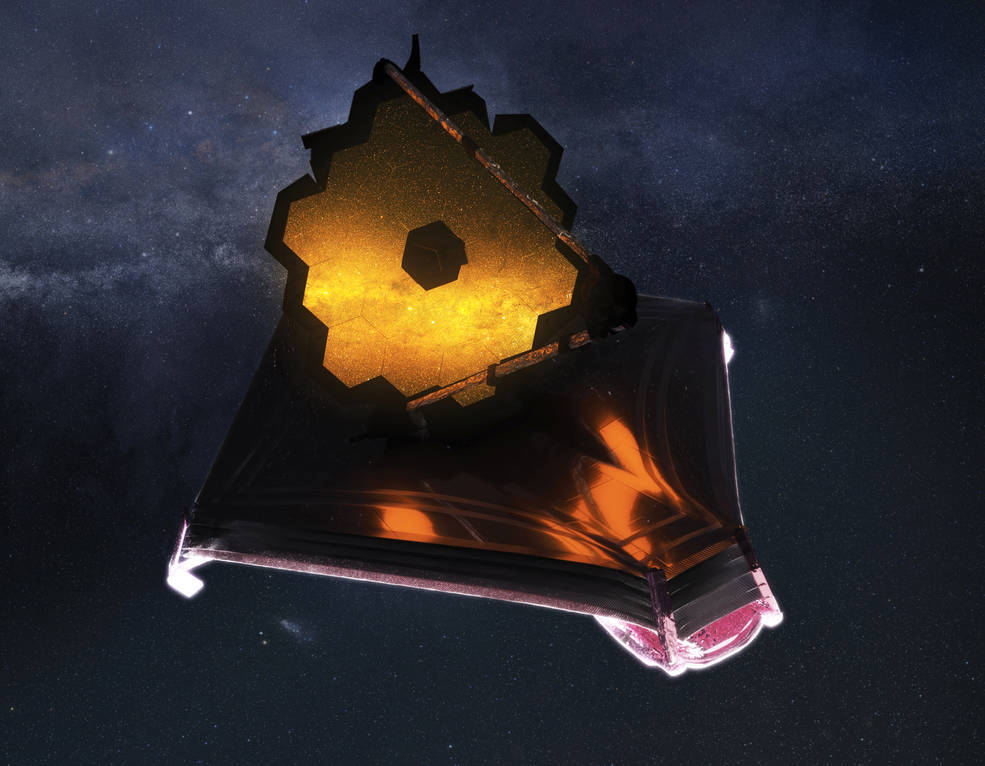
NASA, in partnership with ESA (European Space Agency) and CSA (Canadian Space Agency), will release the James Webb Space Telescope’s first full-color images and spectroscopic data during a live broadcast beginning at 10:30 a.m. EDT Tuesday, July 12, from NASA’s Goddard Space Flight Center in Greenbelt, Maryland.
Released one by one, these first images from the world’s largest and most powerful space telescope will demonstrate Webb at its full power as it begins its mission to unfold the infrared universe.
Each image will simultaneously be made available on social media, as well as on the agency’s website at:
http://www.nasa.gov/webbfirstimages
Embargoed access to Webb’s first images will not be available prior to their public release.
The following is a list of activities for the release (all times Eastern):
Friday, July 8
NASA will share the list of cosmic targets for Webb’s first images and spectra on the agency’s website.
Tuesday, July 12 (Image Release Day)
9:45 a.m. – Live, opening remarks by agency and Webb leadership will air on NASA TV, the NASA app, and the agency’s website ahead of the first images release.
10:30 a.m. – Live coverage of the image release broadcast will air on NASA TV, the NASA app, and the agency’s website. The public also can watch live on Facebook, Twitter, YouTube, Twitch, and Daily Motion.
12 p.m. – Following the live broadcast, NASA and its partners will hold a joint media briefing at NASA Goddard. The briefing will livestream on NASA TV, the NASA app, and the agency’s website. Participants include:
- Eric Smith, Webb program scientist and Astrophysics Division chief scientist, NASA Headquarters
- Knicole Colón, Webb deputy project scientist for exoplanet science, NASA Goddard
- René Doyon, principal investigator for the Canadian Near-Infrared Imager and Slitless Spectrograph, University of Montreal
- Christopher Evans, Webb project scientist, ESA
- Klaus Pontoppidan, Webb project scientist, STScI
- Jane Rigby, Webb operations project scientist, NASA Goddard
- Amber Straughn, Webb deputy project scientist for communications, NASA Goddard
In-person registration is closed; media may register to participate virtually by completing this form by 3 p.m. Monday, July 11.
3 p.m. – Live Interview Opportunities: From 3 to 7 p.m., Webb mission experts will be available to conduct live, remote interviews with broadcast media, in both English and Spanish. Details about scheduling these interviews are available online. Members of the media seeking interviews outside of the windows mentioned in this advisory should complete this media interview request form.
NASA’s media accreditation policy for on-site and virtual activities is available online. The agency will soon provide further details to those who register their interest, including COVID-19 safety protocols. Due to space limitations, NASA may be unable to accommodate all requests for on-site attendance. Media and members of the public may ask questions on social media using #UnfoldtheUniverse.
Wednesday, July 13
6 a.m. – Live Interview Opportunities: From 6 a.m. to 1 p.m., Webb mission experts will be available to conduct live, remote interviews with broadcast media, in both English and Spanish. Details about scheduling these interviews are available online. Members of the media seeking interviews outside of the windows mentioned in this advisory should complete this media interview request form.
1 p.m.: NASA en español social media event
NASA will broadcast a live social media event in Spanish on its NASA en español YouTube, Facebook, and Twitteraccounts. Webb experts Begoña Vila and Néstor Espinoza will discuss the release of the first images and take questions from followers.
3 p.m.: NASA Science Live
Webb experts will answer questions about the first images and data in a NASA Science Live show. The broadcast, Webb’s First Full-Color Images Explained, will air live on the NASA Science Live website, as well as YouTube, Facebook, and Twitter. Viewers of this episode can submit questions on social media using the hashtag #UnfoldtheUniverse or by leaving a comment in the chat section of the Facebook or YouTube stream.
NASA Social
The agency will host an in-person NASA Social Tuesday, July 12, and Wednesday, July 13. Participants will join as guests for the in-studio filming of the televised broadcast at NASA Goddard, tour NASA Goddard and STScI facilities, and interact with experts from the Webb mission.
Social media users can also join a virtual global social event on Facebook to get a behind-the-scenes look at the mission and celebrate Webb’s first images.
Webb Community Events
The public can also join in the release of the first full-color images by attending one of the official Webb Space Telescope Community Events taking place across the country this summer. The list of events celebrating Webb’s first images is available online and updated frequently.
Webb, an international partnership with ESA and CSA, launched Dec. 25 from Europe’s Spaceport in Kourou, French Guiana. After unfolding into its final form in space and successfully reaching its destination 1 million miles from Earth, the observatory now is completing the months-long process of preparing for science operations. Webb will explore every phase of cosmic history – from within the solar system to the most distant observable galaxies in the early universe, and everything in between.
Quelle: NASA
